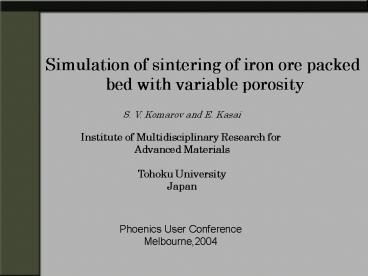Simulation of sintering of iron ore packed - PowerPoint PPT Presentation
1 / 27
Title:
Simulation of sintering of iron ore packed
Description:
Hematite (Fe2O3) 0.82. Carbon(C) 0.03. Limestone (CaCO3) 0.15. Preheated air. Hematite (Fe2O3) 1.0. The process related physical phenomena. 1.Momentum transfer ... – PowerPoint PPT presentation
Number of Views:880
Avg rating:3.0/5.0
Title: Simulation of sintering of iron ore packed
1
Simulation of sintering of iron ore packed bed
with variable porosity
S. V. Komarov and E. Kasai Institute of
Multidisciplinary Research for Advanced
Materials Tohoku University Japan
Phoenics User Conference Melbourne,2004
2
Flowchart of steel production
3
Sintering process concept
region of interest
4
A schematic representation of sintering process
Preheated air
Sintered part
Heat wave
Initial materials 1.Blend ore 2.Coke 3.Limestone
Exhaust gas N2,O2,CO2
5
Principle of big pellet aging
Induction bed for combustion/sintering
Large pellets for aging
6
There are many parameters involved, which
determine the system behavior. An experimental
investigation would be too hard and costly.
Many thanks to friendly and highly skilled
support team in Tokyo
Objective of this study
- Development of a Phoenics-code based model which
- could predict influences of such parameter as
- - void fraction
- - pellet size
- initial temperature and flow rate of gas
- coke and limestone content
- ignition time
- on heat propagation over induction bed to large
pellets
7
Computational domain and its physical prototype
Packed bed
Preheated air
Air inlet
O
A
- Spherical
- pellet
- - ?0 0.25
- R 2.5 cm
- dp0.5 mm
- Fe2O3
Wall
Axis
8.0 cm
- Induction
- bed
- -?00.40.9
- dp2 mm
- Fe2O3,C
- CaCO3
z
4.0 cm
r
B
C
Exhaust gas outlet
8
The sintering process chemistry
Hematite (Fe2O3) 1.0
Preheated air
9
The process related physical phenomena
1.Momentum transfer
Preheated air
2.Two phase heat transfer - convection (gas)
- diffusion (gas,solid) - radiation
(interparticle space) - heat exchange
(gas-solid interface) - heat generation (C
combustion) - heat absorption (CaCO3
decomposition, CaOFe2O3 melting)
3. Mass transfer (only gas phase) - convection
(O2,N2,CO2) - diffusion (O2,N2,CO2) - gas
sourcing (CO2) and sinking (O2)
10
Kinetics of graphite combustion
CO2 CO2
combustion rate
specific area
overall rate coefficient
k06.532?105 (m/sK0.5) Ea 1.839?105 (J/molK)
chemical reaction rate coefficient
mass transfer rate coefficient
11
Sherwood and Nusselt numbers for sphere
Sh
12
Kinetics of the other reactions
Example for reaction (1)
?T10 Td1123 K
f1 function of kinetic factor rl reaction
rate Ql reaction heat Qc graphite combustion
heat rc- graphite combustion rate
Heat supply rate
13
Initial porosity
Wall effect
Mathematical formulation
14
Equation of motion
where
Ergun equation
- dp - particle diameter
- - void fraction (porosity)
- ?g - gas viscosity
- ?g - gas density
15
Equations of continuity and mass conservation
(i CO2,O2,N2)
rc is the carbon combustion rate rl is the
lime decomposition rate Mi is the molecular
weight
16
Equation of energy conservation (gas phase)
Gas-particle heat exchange rate
Concept of C combustion
O2
C
Reaction front
(fixed flux)
- - part of C combustion heat
- going directly to solid phase
- (? 0.5)
17
Equation of energy conservation (solid phase)
?Rad - radiative conductivity according to
Rosseland diffusion model
?- Stephan-Boltzmann constant (5.67?10-8), ?s -
scattering coefficient ?- the reflectivity
coefficient (0.5) , Ts solid temperature
18
Equation of energy conservation (solid phase)
Qi and ri are heat effect and rate of appropriate
reactions l - CaCO3CaOCO2
m - CaOFe2O3(CaOFe2O3)
f,s - (CaOFe2O3)CaFe2O4
19
Boundary and initial conditions
Initial chemical composition and porosity
Air (Ta)
Zone Fe2O3 C CaCO3 ? A 0.82
0.03 0.15 0.40 B 1.0 0.0
0.0 0.25
A
Air velocity at inlet
B
W1 is defined from condition ?g?W1const (1.2) V1
0
Air temperature at inlet
Initial temperature
TgTs25OC
20
Setting of solver options
Grid type BFC 20?48 Time
dependence unsteady 1s ? 600 step 600 s
Flow laminar One-phase
mode (ONEPHST) Total number of iteration
100 Global convergence criteria 0.5 Equation
formulation Elliptic GCV Differencing schemes
Hybrid
21
Example of calculated results.Velocity vector
t 90 s
180 s
330 s
22
Carbon mass fraction and heat generation
Carbon mass fraction
Heat generation
23
Solid temperature and limestone fraction
Temperature of solid phase
Limestone fraction
24
Solid temperature and melted phase fraction
Temperature of solid phase
Melted phase fraction
25
Solid temperature and solid phase fraction
Temperature of solid phase
Solidified phase fraction
26
Carbon mass fraction and void fraction
Carbon mass fraction
Porosity
27
Conclusions
Phoenics code has been applied to the problem of
iron ore sintering process which includes coke
ignition and flame front propagation through the
sintering bed It is shown that Phoenics can be
used to simulate transient two-phase problems
under one-phase setting option Ground coding
allows to simulate gas flow, heat and mass
transfer through bed of variable porosity The
predicted results seem to be realistic but the
model needs to be validated against experimental
data































